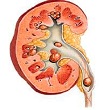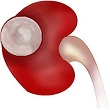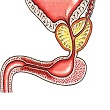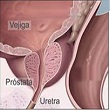The Urology Service at the National Center for Minimally Invasive Surgery was created due to the need of introducing and developing Urologic Laparoscopic Surgery in Cuba. It is the most experienced service in our country in performing these procedures since it has carried out the greatest amount of them and has introduced, developed and generalized most of the laparoscopic urology techniques carried out at present. This service is composed of professors who have been trained in internationally recognized centers like the Lozano Blesa Hospital, in Zaragoza, Spain. Besides laparoscopic surgery, other minimally invasive procedures are performed, like percutaneous renal surgery and others that are part of the therapeutic resources of what has come to be known as Endourology.
Transurethral Resection of Prostate (TURP) | Laparoscopic nephrectomy | Laparoscopic Pyeloplasty | Laparoscopic ureterolithotomy

Urinary lithiasis is the presence of urinary calculus in the kidney, ureters, bladder and urethra, and represents one of the most common urological problems in the daily practice both of the general doctor and the urologist. Depending on the location of the lithiasis, surgical treatment is performed in different ways
Renal Lithiasis
Percutaneous Nephrolithotomy is a procedure to locate, fragment and extract renal calculi by means of percutaneous nephrostomy with the use of an endoscopic device called nephroscope and of calculus fragmentation and extraction instruments.
Ureteral Stones
Laparoscopic ureter lithotomy: Laparoscopic ureter lithotomy is an efficient procedure to extract
ureteral lithiasis when other techniques have failed, such as extracorporeal shock wave lithotripsy
(ESWL) or ureteroscopy.
Ureteroscopy is a kind of treatment that is performed with a small-caliber endoscope which is
introduced through the lower urinary tract up to the lithiasis site in order to extract it. It is a
common procedure; success rates are high and the risk for complication is low.
Bladder Stones
CCystolitholapaxy and Cystolithotomy.
Physician Team:
Tania González León, MD, PhD
Maikel Quintana Rodríguez, MD
Michel Hernández Campoalegre, MD
Contact: tursalud@cce.sld.cu

Benign Kidney Diseases
Cysts, congenital malformations, others that require nephrectomy: total or partial laparoscopic
nephrectomy offers the patient a shorter hospital stay, a faster recovery and the same results
compared to the conventional open technique.
Usually, surgery takes from 2 to 4 hours long. It is performed by making from 3 to 4 one-cm incisions
in the abdomen. The kidney is extracted through a 5-10 cm long incision, depending on its size.
Malignant Kidney Diseases
Laparoscopic ureter lithotomy: Laparoscopic ureter lithotomy is an efficient procedure to extract ureteral lithiasis when other techniques have failed, such as extracorporeal shock wave lithotripsy (ESWL).or ureteroscopy. Ureteroscopy is a kind of treatment that is performed with a small-caliber endoscope. It is a common procedure, its success rates are very high and the risk for complications is low.
Physician Team:
Tania González León, MD, PhD
Maikel Quintana Rodríguez, MD
Michel Hernández Campoalegre, MD
Contact to: tursalud@cce.sld.cu

Vesicovaginal Fistula.
Ureterovaginal Fistula.
Ureteral Stenosis.
Pyeloureteral Union Syndrome.
Physician Team:
Tania González León, MD, PhD
Maikel Quintana Rodríguez, MD
Michel Hernández Campoalegre, MD
Contact to: tursalud@cce.sld.cu

Prostate Surgery (Benign Prostatic Hyperplasia):
Transurethral prostatectomy.
Bladder Cancer.
Ureteral Stenosis.
Physician Team:
Tania González León, MD, PhD
Maikel Quintana Rodríguez, MD
Michel Hernández Campoalegre, MD
Contact to: tursalud@cce.sld.cu